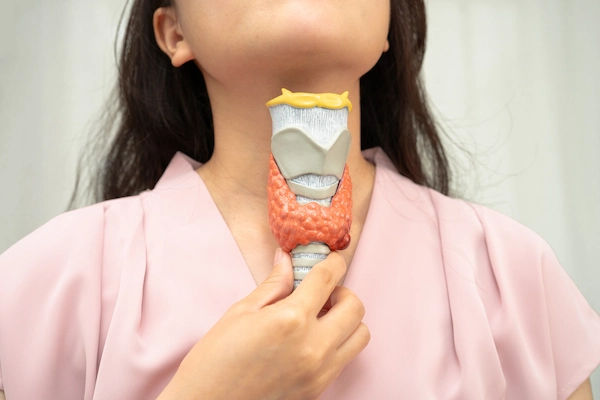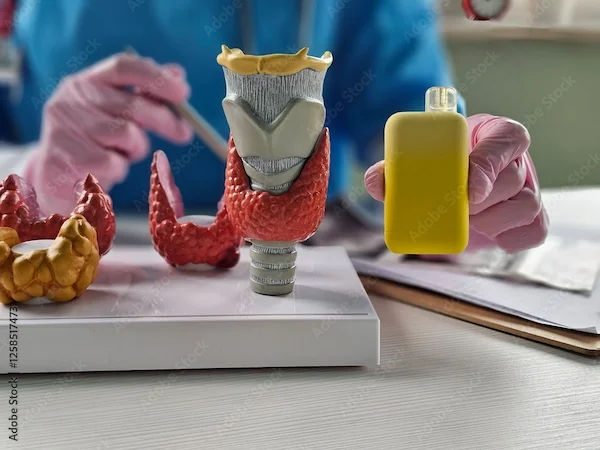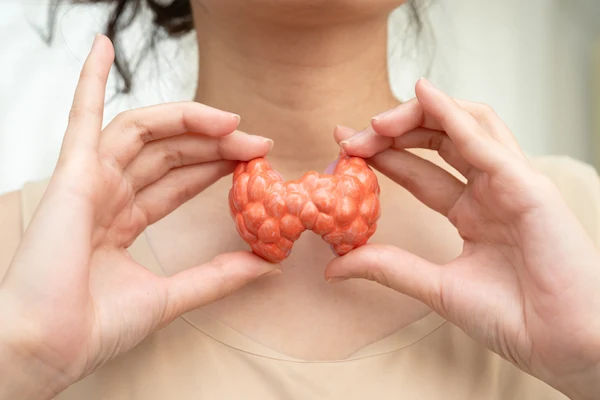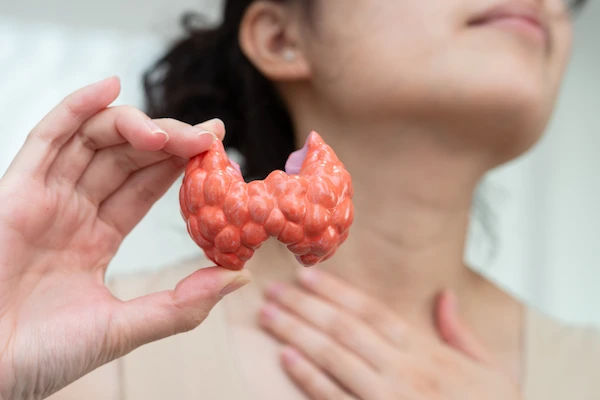What Leads To Signs Of Hyperthyroidism
Discover the common causes and risk factors that lead to the signs and symptoms of hyperthyroidism (overactive thyroid). Learn about Graves' disease, thyroiditis, and more. Get informed!

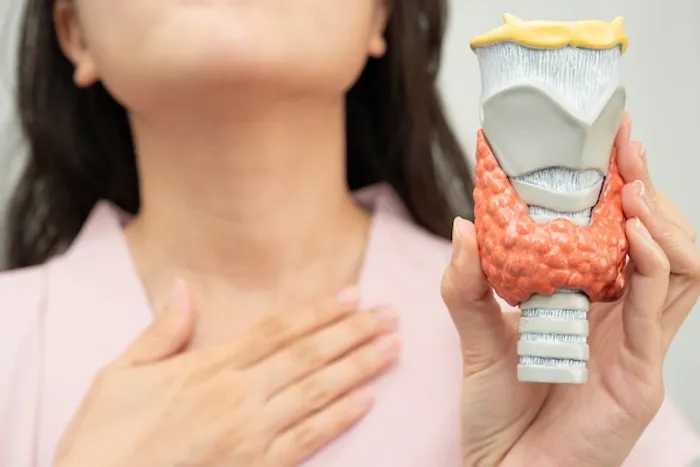
Introduction
Feeling jittery, hot, or oddly out of breath? Losing weight despite eating more? These can be signs of hyperthyroidism—when your thyroid gland makes too much thyroid hormone and your body’s “engine” revs too high. But hyperthyroidism isn’t just one condition. Different root causes—from autoimmune Graves’ disease to overactive thyroid nodules, thyroiditis, or even extra iodine—can all lead to the same telltale signs. Understanding what drives those signs is the key to getting the right diagnosis and the right treatment.
In this guide, we’ll break down how the thyroid normally works, what leads to signs of hyperthyroidism, and how to recognize symptoms early. You’ll see how doctors pinpoint the cause with simple blood tests and imaging, what treatment options fit different situations, and how to protect your heart, bones, and eyes while you recover. We’ll also cover special scenarios like pregnancy, older adults, and postpartum thyroiditis. If symptoms persist beyond two weeks, consult a doctor online with Apollo24|7 for further evaluation. And if tests are needed, Apollo24|7 offers a convenient home collection for thyroid function tests. Let’s demystify hyperthyroidism so you can take confident, informed steps toward feeling like yourself again.
A quick primer: how the thyroid works and why signs appear
Your thyroid, a small butterfly-shaped gland in your neck, makes the hormones thyroxine (T4) and triiodothyronine (T3). These hormones set your metabolic pace—how fast your heart beats, how much heat you produce, how quickly you use energy, and even how your brain and muscles function. The pituitary gland in your brain oversees this system via thyroid-stimulating hormone (TSH), forming the hypothalamic–pituitary–thyroid (HPT) axis. If T3/T4 are high, TSH drops; if T3/T4 are low, TSH rises. In hyperthyroidism, excess T3/T4 suppress TSH and speed up the body’s systems.
Why the classic signs? When T3/T4 surge, your heart becomes more sensitive to adrenaline-like signals. This leads to palpitations, a fast pulse, and sometimes atrial fibrillation. Metabolism accelerates, so you burn calories quickly (weight loss) and generate heat (heat intolerance, sweating). Muscles catabolize protein, causing weakness and tremors. The gut speeds up (frequent stools), the brain “over-revs” (anxiety, irritability), and sleep suffers. Skin and hair turnover increases, often causing hair thinning and warm, moist skin. These mechanisms explain why seemingly unrelated symptoms can cluster together in hyperthyroidism.
Two subtleties matter. First, “thyrotoxicosis” refers to having too much thyroid hormone effect; “hyperthyroidism” means your thyroid gland itself is overactive. Thyroiditis, for example, can cause thyrotoxicosis without true hyperthyroidism by spilling preformed hormones. Second, subclinical hyperthyroidism features low TSH with normal T3/T4; symptoms may be mild or absent, yet risks like atrial fibrillation and bone loss can still increase over time. Understanding this physiology helps you connect the dots between hormone excess and outward signs.
Consult a Top General Physician
The HPT axis (brain-thyroid loop) in plain language
The hypothalamus nudges the pituitary, the pituitary releases TSH, and the thyroid responds with T4 and T3. High T3/T4 tells the brain “we have enough,” so TSH falls. In hyperthyroidism, this feedback is overridden—either by the thyroid being overstimulated (as in Graves’ disease) or by autonomous nodules.
T3/T4 basics: what these hormones do in your body?
T3 is the more active hormone; much of it comes from T4 converted in tissues. T3/T4 regulate oxygen use, heart contractility, and heat production. Too much = too “fast.”
Why does excess hormone speed up metabolism and heart rate?
Thyroid hormones increase beta-adrenergic receptor density and mitochondrial activity—hence tremor, tachycardia, and heat intolerance.
Root causes that lead to signs of hyperthyroidism
Hyperthyroidism has multiple causes, and pinpointing which one you have guides treatment.
- Graves’ disease (60–80% of cases) is an autoimmune condition where antibodies called TRAb stimulate the TSH receptor, pushing the thyroid to overproduce hormones. It often presents with diffuse goiter and sometimes eye changes (thyroid eye disease)
- Toxic adenoma and toxic multinodular goiter are autonomous nodules that make thyroid hormone without pituitary control. These are more common in older adults and in regions with long-standing iodine deficiency.
- Thyroiditis (painless, subacute, or postpartum) causes inflammation and leakage of stored hormone, leading to a temporary thyrotoxic phase, followed by a hypothyroid phase, and often resolution. Postpartum thyroiditis affects some women within the first year after delivery.
- Iodine-induced hyperthyroidism can occur after contrast scans, supplements, or amiodarone—a heart medication rich in iodine. Over-replacement of thyroid hormone (levothyroxine or liothyronine) can also lead to thyrotoxicosis if dosing overshoots
- Rare causes include TSH-secreting pituitary tumors and struma ovarii (ovarian tissue producing thyroid hormone).
Risk factors overlap: female sex, autoimmune history, family history of thyroid disease, smoking (which worsens Graves’ eye disease), recent pregnancy, high iodine exposure, and older age for nodular disease [2][6]. Recognizing the driver is crucial. For example, antithyroid drugs help Graves’, but not the thyrotoxic phase of thyroiditis, which is hormone “spillage,” not overproduction.
Graves’ disease (autoimmune overstimulation)
Features: diffuse goiter, possible thyroid eye disease, positive TRAb antibodies, high uptake on radioactive iodine uptake (RAIU) scans.
Toxic nodules and multinodular goiter
Features: one or more nodules producing hormone, often normal or low TSH over time, “hot” nodules on scans; ultrasound shows nodules.
hyroiditis (including postpartum thyroiditis)
Features: transient thyrotoxic phase with low uptake on RAIU; can follow pregnancy or viral illness; neck pain in subacute (de Quervain) thyroiditis.
Iodine excess, medications, and rare causes
Features: history of iodine contrast, kelp/seaweed supplements, amiodarone; or exogenous hormone use. Rarely, pituitary causes.
Subclinical hyperthyroidism: when labs change before symptoms
Low TSH with normal T4/T3; important in older adults due to heart/bone risks, even with few signs.
Recognizing the signs: body, mood, and more
Hyperthyroidism shows up head-to-toe, but patterns help.
- Early/subtle signs: feeling hot, sweating more, fine tremor, increased appetite with weight loss, anxiety or irritability, sleep difficulty, and palpitations. In women, early signs may mimic perimenopause (hot flashes, irregular periods), which delays diagnosis.
- Heart, muscle, gut: resting heart rate often >90–100 bpm; exertional shortness of breath; new or worsened high blood pressure; bowel frequency increases; muscle weakness, especially in thighs and shoulders; in older adults, symptoms may be “masked,” presenting mainly as fatigue or atrial fibrillation.
- Skin, hair, eyes: warm, moist skin; thinning hair; brittle nails. Graves’ eye disease can cause gritty eyes, light sensitivity, eyelid retraction, bulging (proptosis), and double vision. Rarely, pretibial myxedema (skin thickening on shins) occurs in Graves’.
- - Mood and cognition: anxiety, restlessness, poor concentration, and mood swings.
- Hyperthyroidism can aggravate panic-like symptoms, sometimes leading to misdiagnosis as a primary anxiety disorder.
Case example: A 34-year-old woman with three months of palpitations, heat intolerance, and 5 kg unintentional weight loss presents with a resting pulse of 105 and a fine hand tremor. Her TSH is suppressed, and free T4 is high—classic for overt hyperthyroidism, ultimately diagnosed as Graves’ with positive TRAb.
Early signs and subtle clues (weight loss, heat intolerance)
Track unintentional weight change, clothing tolerance to heat, and resting heart rate trends.
Heart, muscle, and gut symptoms (palpitations, tremor, diarrhea)
Palpitations and tremor are high-signal clues to check TSH promptly.
Skin, hair, and eye changes (including Graves’ eye disease)
Eye symptoms plus thyroid signs suggest Graves’ and warrant specialist input.
When signs mimic anxiety, menopause, or overtraining
Overlap is common; lab testing clarifies the diagnosis.
Getting the right diagnosis: tests and imaging
Diagnosis starts with TSH. In hyperthyroidism, TSH is low or undetectable. Free T4 and total/free T3 distinguish overt (high T4/T3) from subclinical (normal T4/T3) hyperthyroidism.
- Antibodies: TRAb (TSI) confirms Graves’ disease; TPO antibodies support autoimmune thyroid disease (common in Graves’ and thyroiditis).
- Imaging: A radioactive iodine uptake (RAIU) scan maps thyroid activity. Diffuse high uptake suggests Graves’; focal “hot” nodules suggest toxic adenoma; low uptake points to thyroiditis or exogenous hormone. Thyroid ultrasound evaluates nodules and blood flow; it’s useful when nodules are suspected or in pregnancy (no radiation).
- ECG: To assess arrhythmias (e.g., atrial fibrillation). Bone density may be checked if hyperthyroidism has been prolonged due to bone loss risk.
Lab examples:
- Overt hyperthyroidism: TSH <0.01 mIU/L; free T4 elevated; free/total T3 elevated.
- T3 toxicosis: low TSH, normal T4, high T3—often early Graves’ or nodular disease.
- Subclinical hyperthyroidism: low TSH, normal T4 and T3—monitoring and risk assessment are key, especially if TSH <0.1 mIU/L.
Practical tip: If you have symptoms beyond two weeks or a resting pulse persistently above 100, consult a doctor online with Apollo24|7 for further evaluation. If labs are ordered, Apollo24|7 offers home collection for TSH, free T4, and T3 tests to make the process convenient.
TSH, free T4, and total/free T3—how to interpret patterns
Think “TSH first,” then confirm with free T4/T3 to gauge severity.
Antibodies (TRAb, TPO), ultrasound, and radioactive iodine uptake scans
Match the pattern: diffuse high uptake = Graves’; focal high uptake = nodules; low uptake = thyroiditis/exogenous hormone.
Decoding lab results: examples and what they usually mean
T3 toxicosis can be an early clue to nodular or Graves’-driven disease.
Risks and complications if you ignore the signs
Untreated hyperthyroidism can strain multiple systems.
- Heart: Persistent tachycardia and high thyroid hormone levels raise the risk of atrial fibrillation, which can lead to stroke. Treating hyperthyroidism reduces these risks, but early control matters.
- Bones: Thyroid hormones accelerate bone turnover, causing bone loss and higher fracture risk, especially in postmenopausal women. Calcium, vitamin D, and weight-bearing exercise support bone health during and after treatment.
- Reproductive health: Irregular periods, reduced fertility, and pregnancy complications (miscarriage, preterm birth) can occur if hyperthyroidism is not controlled. Managing Graves’ disease prior to conception is ideal
- Thyroid storm: A rare but life-threatening escalation of thyrotoxicosis, often triggered by infection, surgery, or trauma. Symptoms include fever, severe agitation, delirium, vomiting/diarrhea, and heart failure. Mortality remains significant without prompt treatment, underscoring the importance of early disease control.
Older adults may present atypically (“apathetic” hyperthyroidism) with fatigue and weight loss but fewer overt signs, while being at higher risk of arrhythmias and heart failure. If you have heart palpitations, chest pain, or fainting, seek urgent care. If your condition does not improve after trying these methods, book a physical visit to a doctor with Apollo24|7.
Heart rhythm problems, bone loss, and fertility impacts
Control of hormone levels protects heart rhythm and bone density; preconception planning improves outcomes in pregnancy.
Thyroid storm: rare, life-threatening emergency
Know warning signs: high fever, confusion, severe tachycardia—call emergency services.
Special considerations in pregnancy and older adults
Treatment choices and targets differ to protect both mother and baby; older adults require gentler dosing and rhythm monitoring.
Treatment options tailored to cause
Treatment is personalized—by cause, age, severity, and patient preference.
- Symptom relief: Beta-blockers (e.g., propranolol) quickly reduce palpitations, tremor, and anxiety while definitive treatments take effect. They don’t fix hormone excess but improve quality of life.
- Antithyroid drugs: Methimazole is first-line for most adults; propylthiouracil (PTU) is preferred in the first trimester of pregnancy and for certain thyroid storm scenarios. Side effects range from minor rash to rare but serious agranulocytosis (dangerously low white blood cells) and liver injury; sudden sore throat/fever warrants urgent blood count testing. Remission rates for Graves’ disease after 12–18 months of therapy vary (about 30–50%); relapse is possible, prompting discussion of longer therapy or definitive treatment.
- Radioactive iodine (RAI): A common definitive treatment for Graves’ disease and toxic nodular goiters. It gradually reduces overactivity, often resulting in hypothyroidism requiring levothyroxine. Not used during pregnancy or in severe active eye disease without precautions.
- Eye disease risk can be mitigated with steroids when indicated [6].
- Surgery (thyroidectomy): Recommended for very large goiters, suspicion of cancer, compressive symptoms, or when medications/RAI aren’t suitable. Risks include temporary or permanent low calcium (parathyroid impact) and voice changes; when performed by experienced surgeons, complication rates are low. Post-surgery, lifelong levothyroxine is usually needed.
Special situations:
- Pregnancy: PTU in the first trimester, then often switch to methimazole; aim to keep free T4 in the upper normal range to avoid fetal hypothyroidism. Avoid RAI.
- Thyroid eye disease: Control thyroid levels, stop smoking, manage eye symptoms; severe cases may require steroids, teprotumumab, or orbital procedures via specialists .
Unique insight: Think of treatment in layers—calm the symptoms (beta-blockers), control hormone production (antithyroid drugs), and choose a definitive approach (RAI or surgery) if relapse risk is high or long-term drug therapy isn’t ideal.
Beta-blockers for symptom control
Rapid relief within days; dose individualized; discuss contraindications like asthma.
Antithyroid drugs (methimazole, PTU): pros, cons, monitoring
Monitor blood counts and liver enzymes if symptoms suggest side effects; periodic thyroid labs guide dose.
Radioactive iodine therapy: who benefits, what to expect
Most patients transition to hypothyroidism over months—planned and manageable with levothyroxine.
Surgery: indications, recovery, and long-term care
Choose a high-volume thyroid surgeon to minimize risks.
Treating Graves’ eye disease
Protect eyes with lubrication, selenium in mild cases, and avoid smoking; specialist care for moderate-to-severe disease.
Living well during and after hyperthyroidism
Lifestyle can’t cure hyperthyroidism, but it supports recovery and protects your heart and bones.
- Diet and iodine: Avoid high-dose iodine supplements (kelp/seaweed tablets). Normal dietary iodine is fine, but check labels on multivitamins and cough syrups. Adequate calcium and vitamin D support bone health; discuss vitamin D testing—Apollo24|7 offers a home collection for vitamin D if your clinician recommends it.
- Exercise and sleep: Start with gentle, low-impact activity (walking, light strength work) until your heart rate and muscle strength normalize. Prioritize sleep hygiene to counteract insomnia—consistent bedtimes, cool rooms, and limiting caffeine.
- Stress management: Mindfulness, breathing exercises, and short breaks can reduce adrenaline surges that aggravate palpitations.
- Monitoring and relapse prevention: During active treatment, thyroid labs are typically checked every 4–8 weeks, then every 3–6 months once stable. If you’ve had Graves’ disease, recognizing early relapse signs (palpitations, heat intolerance) and checking labs promptly helps you stay ahead of symptoms.
- Med safety: If you’re on antithyroid drugs, know “stop signs”: fever, sore throat, dark urine, or severe fatigue—seek urgent evaluation for possible agranulocytosis or liver issues.
Unique insight: Keep a simple “thyroid tracker.” Record resting heart rate, weight, sleep hours, and a symptom score (0–10) weekly. Patterns help you and your clinician fine-tune dosing faster.
Diet, iodine awareness, and bone/heart support
Emphasize calcium (food first), vitamin D, and resistance training for bone strength.
Exercise, sleep, and stress management
Small daily wins accumulate; avoid intense heat exposure until symptoms remit.
Monitoring, relapse prevention, and follow-up schedule
Agree on a lab schedule; keep medication timing consistent.
Conclusion
The signs of hyperthyroidism may seem scattered—racing heart, shaky hands, feeling hot, restless sleep—but they point to a single engine running too fast: excess thyroid hormone. What leads to those signs varies, from autoimmune Graves’ disease to hormone-spilling thyroiditis or independent overactive nodules. Fortunately, the path to clarity is straightforward: start with a TSH and free T4/T3 panel, then use antibodies and imaging to pinpoint the cause. From there, you and your clinician can choose targeted treatments—beta-blockers for rapid relief, antithyroid drugs to control production, and, when needed, definitive therapies like radioactive iodine or surgery.
Alongside medical care, practical steps—managing iodine intake, prioritizing sleep, rebuilding strength, and tracking symptoms—help you feel better sooner. If symptoms persist beyond two weeks, consult a doctor online with Apollo24|7 for further evaluation. If tests are needed, Apollo24|7 offers convenient home collection for TSH, free T4/T3, and vitamin D to support bone health. Most importantly, remember that hyperthyroidism is highly treatable. With the right diagnosis and a plan tailored to your cause and life stage, you can calm the “over-revved engine,” protect your health, and get back to your normal pace.
Consult a Top General Physician
Consult a Top General Physician

Dr. Rajib Ghose
General Physician/ Internal Medicine Specialist
25 Years • MBBS
East Midnapore
VIVEKANANDA SEBA SADAN, East Midnapore

Dr. Abhishek Ranjan
General Practitioner
4 Years • MBBS
Kolkata
VDC Clinic, Kolkata
Dr. Naziya Rahim Bhatia
General Surgeon
7 Years • MBBS ,MS
Bengaluru
Apollo Clinic, Sarjapur Road, Bengaluru

Dr. Sougata Kumar
General Practitioner
8 Years • MBBS
East Midnapore
VIVEKANANDA SEBA SADAN, East Midnapore

Dr. Pinaki Mukhopadhyay
General Physician/ Internal Medicine Specialist
32 Years • MBBS
Kolkata
MCR SUPER SPECIALITY POLY CLINIC & PATHOLOGY, Kolkata
(25+ Patients)
Consult a Top General Physician

Dr. Rajib Ghose
General Physician/ Internal Medicine Specialist
25 Years • MBBS
East Midnapore
VIVEKANANDA SEBA SADAN, East Midnapore

Dr. Abhishek Ranjan
General Practitioner
4 Years • MBBS
Kolkata
VDC Clinic, Kolkata
Dr. Naziya Rahim Bhatia
General Surgeon
7 Years • MBBS ,MS
Bengaluru
Apollo Clinic, Sarjapur Road, Bengaluru

Dr. Sougata Kumar
General Practitioner
8 Years • MBBS
East Midnapore
VIVEKANANDA SEBA SADAN, East Midnapore

Dr. Pinaki Mukhopadhyay
General Physician/ Internal Medicine Specialist
32 Years • MBBS
Kolkata
MCR SUPER SPECIALITY POLY CLINIC & PATHOLOGY, Kolkata
(25+ Patients)
More articles from Hyperthyroidism overactive thyroid
Frequently Asked Questions
What is the difference between thyrotoxicosis and hyperthyroidism?
Thyrotoxicosis means too much thyroid hormone effect in the body; hyperthyroidism means the thyroid gland is overproducing hormones. Thyroiditis can cause thyrotoxicosis without true hyperthyroidism.
How are early signs of hyperthyroidism in women different?
Early signs can overlap with perimenopause—heat intolerance, palpitations, mood changes, and irregular periods—so a TSH test is important to distinguish causes.
Can subclinical hyperthyroidism cause problems?
Yes. Even with normal T4/T3, a very low TSH (<0.1 mIU/L) is linked to atrial fibrillation and bone loss, especially in older adults, so monitoring or treatment may be advised.
How long do antithyroid drugs take to work, and what should I watch for?
Symptom relief often begins within 1–2 weeks; labs improve over 4–8 weeks. Watch for sore throat or fever (possible agranulocytosis) and dark urine or severe fatigue (possible liver issues). Seek prompt care if these occur.
What foods or supplements should I avoid with hyperthyroidism?
Avoid high-dose iodine supplements (e.g., kelp tablets) and check multivitamin/cough syrup labels. Normal dietary iodine is acceptable unless your clinician advises otherwise.
